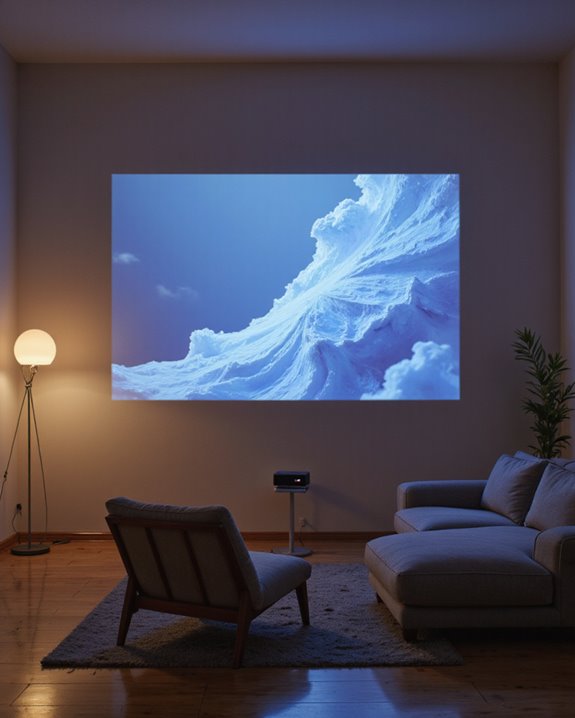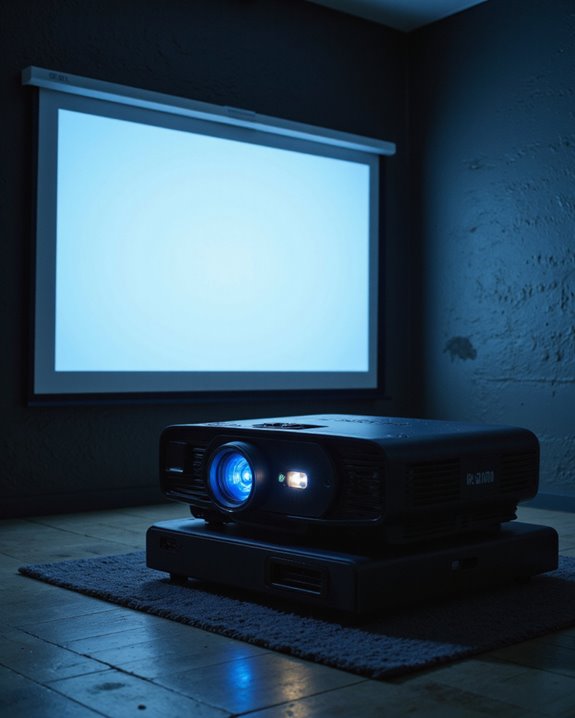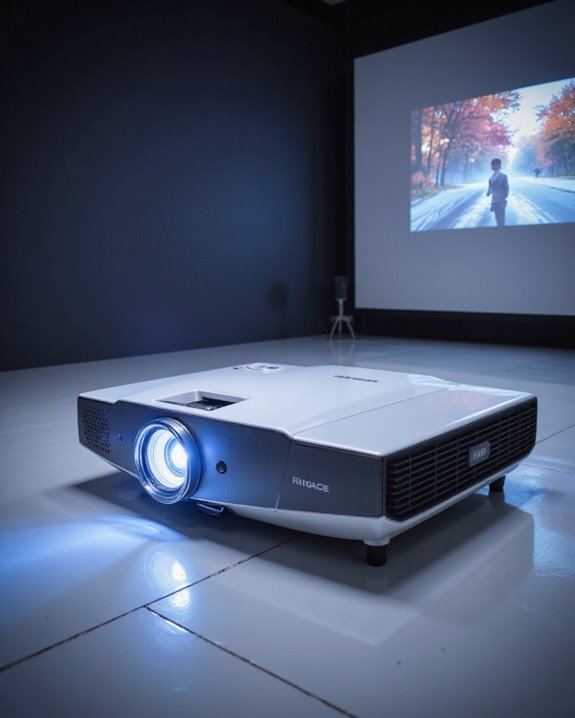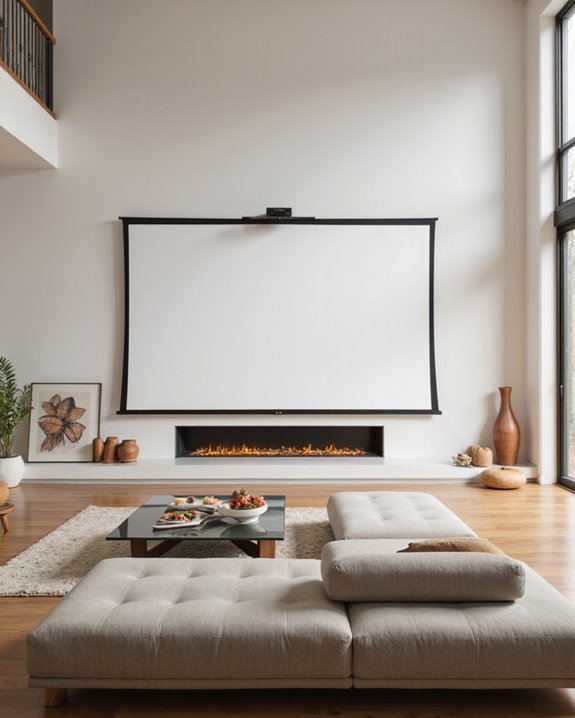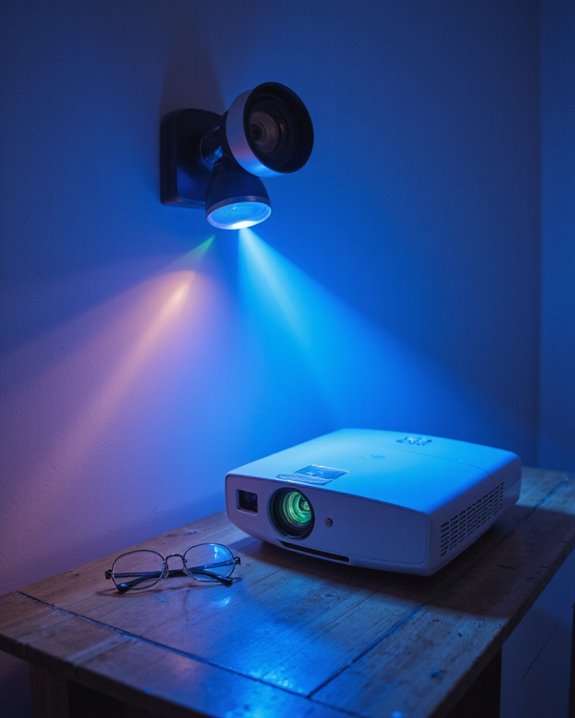Laser projectors can effectively replace TVs, offering larger screen sizes (80-130 inches) and flexible viewing options. Modern laser projectors deliver impressive brightness levels up to 3,500 ANSI lumens, making them suitable for both dark and moderately lit rooms. While TVs excel in very bright environments, projectors provide superior value for screen sizes over 100 inches and create more immersive experiences. The choice ultimately depends on room size, lighting conditions, and viewing preferences – factors that warrant careful consideration before making this significant entertainment upgrade.
Key Takeaways
- Laser projectors can offer larger screen sizes (80-130 inches) than TVs, providing better value for immersive home theater experiences.
- Modern laser projectors achieve high brightness levels (2,700-3,500 ANSI lumens) and maintain consistent performance, competing with TV picture quality.
- Gaming performance on laser projectors approaches TV capabilities, with input lag as low as 16ms and support for 4K resolution.
- Room conditions significantly impact projector effectiveness, with controlled lighting and proper wall space being essential for optimal performance.
- Cost comparison favors projectors for screen sizes over 100 inches, though TVs remain more practical for smaller spaces.
Comparing Image Size and Impact on Home Viewing
When comparing laser projectors to TVs, the most notable difference lies in their image size capabilities and flexibility. While TVs come in fixed dimensions, laser projectors offer remarkable projection flexibility, allowing users to adjust screen sizes based on their viewing space and preferences.
The enhanced image size capabilities of projectors create more immersive visuals, transforming ordinary rooms into home theater experiences. Projectors can display images considerably larger than conventional TVs, often reaching screen sizes of 100 inches or more. This scalability makes them particularly valuable for diverse viewing environments, from intimate home theaters to spacious living rooms. The Valerion Pro 2 demonstrates this versatility with its ability to support projections ranging from 80 to 130 inches, highlighting the adaptability of modern projection technology.
Additionally, projectors provide practical advantages in terms of space optimization. Unlike large TVs that permanently occupy wall space, projector screens can be rolled up when not in use, offering more versatile room arrangements, which is especially beneficial for small or multi-purpose rooms.
Understanding Brightness and Picture Performance
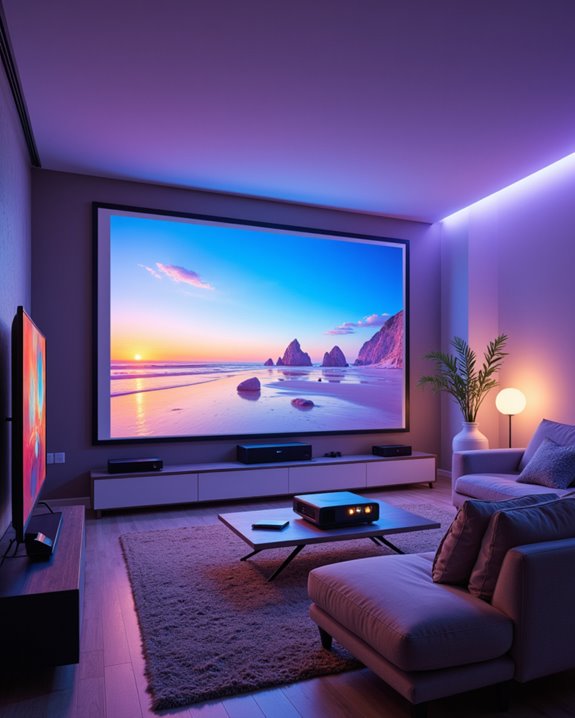
Although both laser projectors and TVs produce digital images, their brightness capabilities and picture performance characteristics differ markedly in key areas. Laser projectors excel in brightness, offering up to 2,700 ANSI lumens, which makes them highly effective in rooms with ambient light. Their consistent brightness levels remain stable over time, unlike traditional lamp-based projectors that dim with age. Modern high-end laser projectors like the AWOL Vision LTV-3500 Pro deliver an impressive 3,500 ANSI lumens.
In terms of picture quality, laser projectors deliver impressive color accuracy through precise laser light control, covering approximately 86% of the DCI-P3 color gamut. While their contrast ratios may not match OLED TVs, they compensate with superior viewing angles and consistent image quality across large screen sizes. The technology also maintains color vibrancy and clarity even in well-lit environments, making them versatile for both day and night viewing. Additionally, brightness consistency over time ensures a reliable viewing experience without significant degradation.
Gaming Experience and Response Times
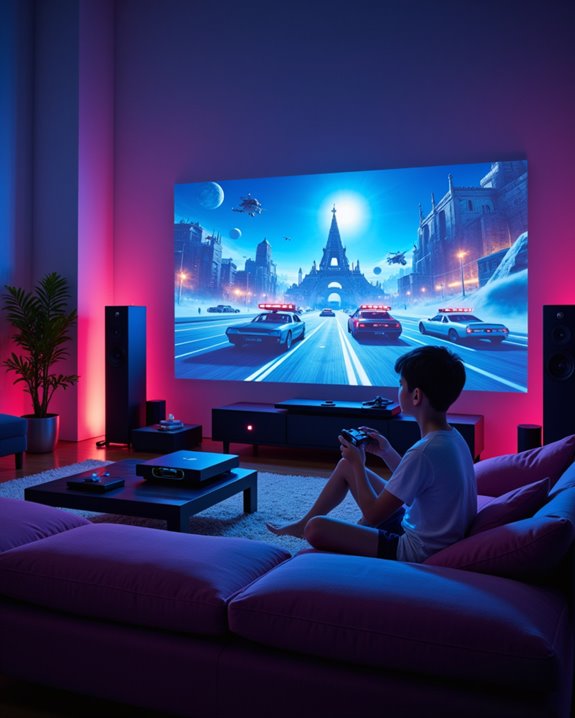
Modern gaming demands quick response times and smooth motion handling, making the choice between laser projectors and TVs particularly important for gamers. When comparing gaming performance, TVs currently hold several advantages. Most gaming TVs support 4K resolution at 120Hz refresh rates, while projectors typically max out at 4K 60Hz, though some can achieve 240Hz at lower 1080p resolution.
Input lag, which affects how quickly the display responds to controller inputs, is competitive on both platforms. Recent gaming projectors can achieve response times as low as 16ms at 60Hz, matching many TVs. DLP projectors offer nearly instant pixel response times, reducing motion blur considerably. Projectors excel in delivering cinematic visual depth through their massive screen sizes ranging from 100-150 inches. Additionally, some projectors feature gaming-specific modes that optimize input lag and image processing for a better experience. However, for gamers seeking the highest image resolution and fastest refresh rates simultaneously, TVs remain the most suitable choice, despite projectors’ ability to create a more immersive gaming experience through larger screen sizes.
Breaking Down the Cost Analysis
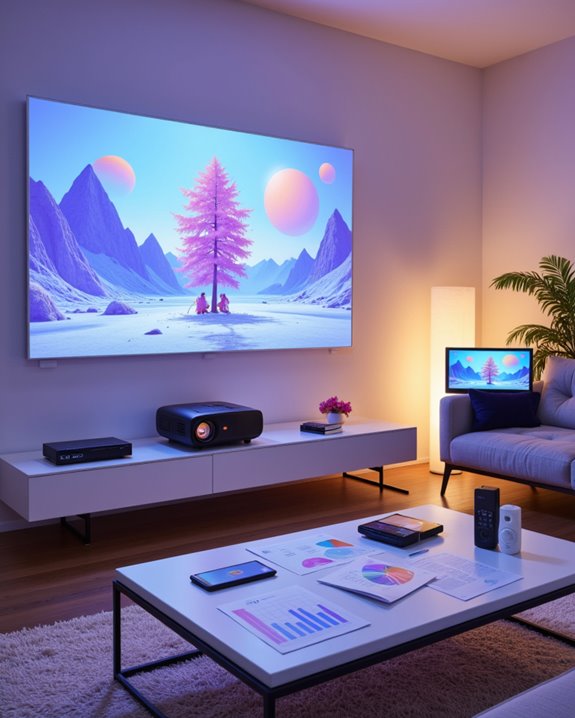
A thorough cost analysis reveals significant differences between laser projectors and TVs across multiple financial factors. The initial investment varies considerably, with cost efficiency favoring projectors for screens larger than 100 inches. While a 100-inch QLED TV might cost $1,899, a complete laser projector setup, including a quality screen ($500-$2,000), can provide more size flexibility for a similar total investment. Short throw projectors can generate images up to 135 inches from just 2 meters away.
Durability factors play a vital role in long-term ownership costs. Laser projectors typically offer extended lifespans and require less maintenance due to fewer moving parts, resulting in reduced repair expenses over time. Additionally, their superior energy efficiency contributes to lower operating costs. Though projectors require an initial screen investment, their ability to scale image size and potential for portability often justify the upfront expense when compared to fixed-size TVs.
Room Setup and Installation Considerations
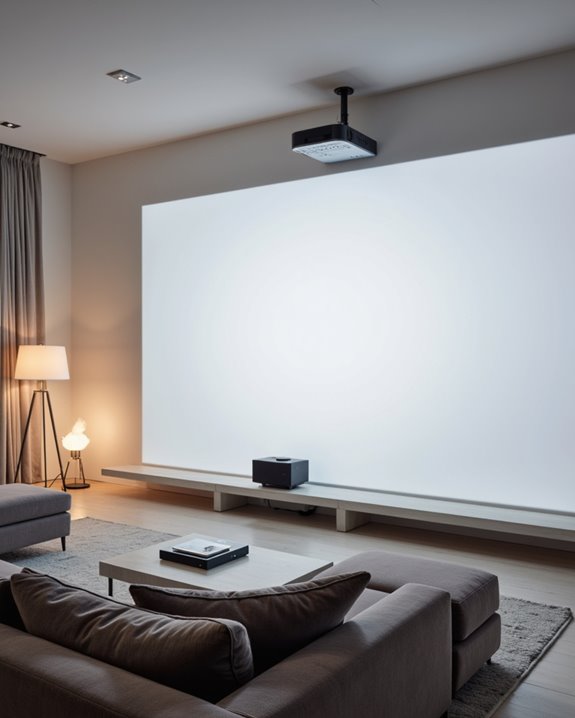
Setting up a laser projector or TV extends beyond simple cost considerations into the practical demands of room configuration and proper installation. The room’s physical characteristics play a vital role in determining the best setup approach, with ceiling height being a key factor that affects mounting options and screen placement.
Laser projector installations require careful attention to safety regulations and structural support. The mounting process must account for proper ventilation, secure attachment to ceiling joists, and compliance with laser safety protocols. For optimal viewing in confined spaces, a short-throw projector can create a 100-inch display from just 4 feet away. Room size directly impacts the achievable screen size and ideal viewing distance, while ambient light control becomes essential for image quality.
TVs generally offer more straightforward installation requirements, typically needing only a stable wall mount or furniture surface, making them a simpler choice for many living spaces.
Smart Features and Entertainment Options

Smart features and connectivity options distinguish today’s laser projectors and TVs in the entertainment landscape. Modern laser projectors come equipped with built-in smart platforms like Android TV, offering seamless access to streaming services and apps. Voice control integration through assistants like Google Assistant enables hands-free operation and convenient navigation. Advanced laser projectors feature Harman/Kardon speakers that deliver powerful, room-filling sound for a complete audiovisual experience.
These projectors deliver immersive entertainment experiences through:
- Support for HDR 10 and Dolby Vision
- Screen sizes ranging from 90 to 150 inches
- 4K resolution capabilities
- Compatibility with popular streaming services
- Chromecast integration for mobile device casting
The integration of wireless connectivity allows users to stream content directly from smartphones and tablets. Multiple HDMI and USB ports accommodate various devices simultaneously, from gaming consoles to computers, making laser projectors versatile entertainment hubs for modern homes.
Making the Right Choice for Your Space
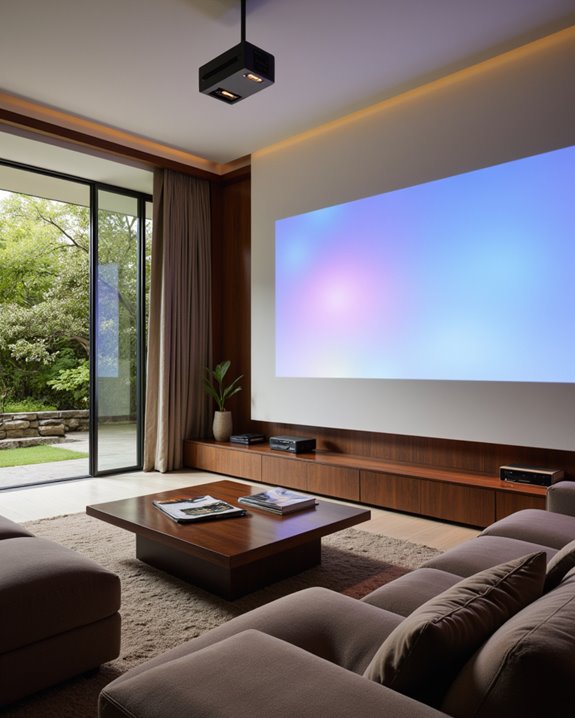
Making informed decisions about display technology involves careful consideration of one’s living space and viewing environment. The choice between a laser projector and TV depends largely on room specifications, ambient lighting conditions, and wall color.
For spaces with controlled lighting and neutral-colored walls, laser projectors offer exceptional flexibility and value, especially in larger rooms where a big-screen TV might be cost-prohibitive. Laser projectors deliver immersive experiences with their high-resolution 4K capabilities. Rooms with high ambient light levels may benefit more from a traditional TV unless paired with a specialized ambient light rejecting (ALR) screen. The physical layout of the space also plays a pivotal role – projectors require appropriate throw distance and mounting options. Small rooms with limited wall space might be better suited for TVs, while spaces with adaptable layouts can take full advantage of a projector’s versatility in screen size and placement options.
Frequently Asked Questions
How Long Do Laser Projectors Typically Last Before Needing Replacement?
Studies confirm laser projectors typically achieve a lifespan of 20,000 to 50,000 hours, equivalent to 11-20 years of regular use. With proper maintenance requirements, these projectors can operate effectively throughout their expected service life.
Can Laser Projectors Damage Eyes if Looked at Directly?
Yes, direct laser exposure from projectors can cause severe eye damage. Eye safety is critical as these devices can harm the retina even with brief exposure. Never look directly into the projector’s lens.
Do Laser Projectors Work Well for Outdoor Movie Nights?
Laser projectors excel for outdoor movie nights, offering superior performance in ambient lighting conditions. Their high brightness and ability to create large projection sizes make them ideal for creating an immersive outdoor cinema experience.
What Happens if Something Blocks the Laser Projector Beam?
When objects intersect the laser beam, they create projector shadows and disrupt image quality. Beam obstruction not only distorts the display but can also pose safety concerns by redirecting light in unexpected directions.
Are Laser Projectors Louder or Quieter Than Traditional Projectors?
In sound level comparisons, laser projectors operate more quietly than traditional projectors. Their reduced cooling requirements and advanced noise reduction features result in lower operational noise, making them preferable for noise-sensitive environments.

